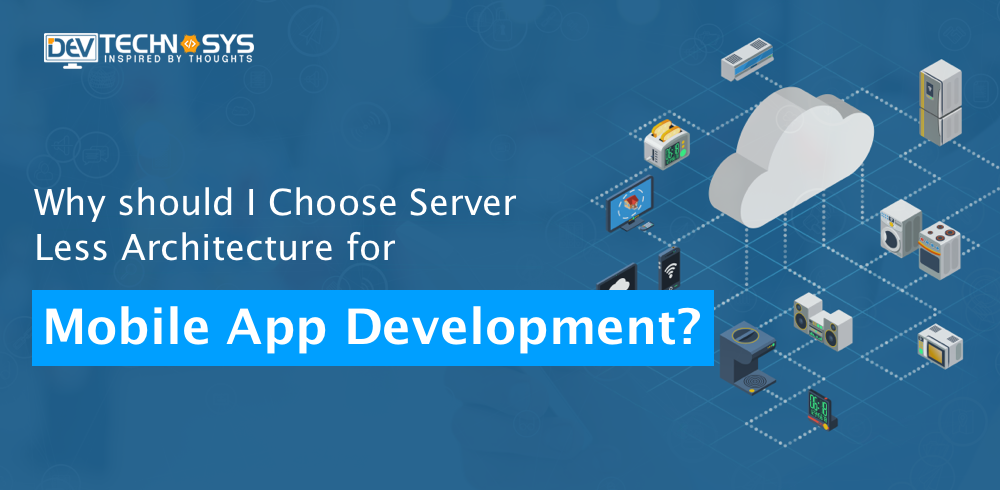Introduction
Since the evolution of technological innovations, the opportunities for millennial have enriched. Every time new buzzwords are interpreted, it portrays an abundance of experiments. These technologies keep on transforming the performance of applications. The current marketplace has leveraged with the advancement in different niche. Among all other, from the last decade, we have witnessed exponential innovations in the IT space. The fundamental objective has been to improve resiliency, business agility, and cost efficiencies. Here, computing ratchets up credit. It solves numerous issues with its abstraction of infrastructure, servers and operating systems. Now serverless computing offers industry incumbents the much-needed computing model to counter competition with the high-tech newcomers. Serverless computing has proven as attractive over traditional infrastructure for every mobile application development company.

What Is Serverless Architecture?
The word ‘Serverless’ can’t be interpreted as ‘No Servers.’ In a broader sense, serverless architecture doesn’t demystify that it can run its code with no need of servers. Serverless computing is defined as an evolution of cloud computing service models from IaaS( Infrastructure-as-a-Service) to PaaS (Platform-as-a-Service) to FaaS(Function-as-a-Service). The Android or iPhone app development services are not required to buy, rent or provision virtual machines or servers to run the back-end code. Furthermore, It is the cloud provider which handles the complexity of managing individual servers and provides an ephemeral compute service, that will execute a piece of code on-demand triggered through requests and events, with the service consumer being charged only for the duration of execution.
Why Choose Serverless Architecture?
Today, serverless platforms become more useful for significant tasks, where individual requests complete in a short time window. Serverless architecture significantly assists every mobile application development company to focus on the core products, not on its infrastructure. Otherwise, maintaining, implementing, debugging, and monitoring the infrastructure, whether to manage them in the cloud or on-site, would be proved outlandish for the developers.
Now, it’s necessary to dive in to understand it’s garnished countenance:
- Low Costs: The most influencing factor before heading up for technology is a cost factor. Every enterprise is more concerned about their short term as well as long term cost. So when you rack up the resources you need to pay unless and until it is through a free source. It also spells similar here for the developers. In other words, you would not be bogged down with the burden of heavy cost. Once app development services like iPhone app development services opt for serverless architecture, it will save a lot of money. It has been offered with a “pay-as-you-go” model that would make you more prudent about further decisions. You are required to pay for a service that is utilized. It writes off the problem when you don’t have a bulk need.
- Secured: Nowadays, the IT sector has exposed to the intense probability of security threats. There is a lack of a proper consolidated mechanism to counter security threats. The unwanted ramifications for iPhone or Android app development services will wear off the real objective. Hence, it has transfigured into the biggest concern for future progression. But that concern has taken down with the use of serverless architecture. It embraced a proper mechanism to provide you with robust security. The latest security would be implemented for your servers because third party services provider monitors and controls it. As a result, it keeps up you away from the pathetic and tiresome task to either fixing the bugs or examining for loopholes.
- Scalability: Today, the extent of the approach matter a lot. It divulges further requirements in different other names. But what patronizes the real objectivity of is to fetch heavy traffic for your project. Therefore, it is imperative to have a road map where its simple to hit maximum extension or reach for your app. The possibility to quench the need of having potential scalability must be meticulously resolved. So here, serverless architecture has come as a solution for all mobile app development services. Usually, scaling relies upon network strength and user location, but it will ensure to be leveraged with high scalability values.
- User Experience: A well-considered and prominent perception that user keeps, is an enriched experience and utilization. The viability of the app would be efficacious once iPhone or Android app development services follow it. So, today it would be necessary to hedge functionalities that cater to the user. Any kind of infrastructure or the laborious development process does not matter for them. All they explore for is the features and relevant functionalities of the app. So, here serverless architecture provides no server issues or downtime. It ensures that the app would perform uninterruptedly and efficiently.
- Facilitates innovation: It helps the product engineers to synthesize more focus on innovations. The efforts towards exploring new initiatives would mitigate the problems of system engineering. Furthermore, it fortifies the utilization of resources. In a broader sense, it manages a serene and streamlined application of DevOps and consistent repetition of development and testing. Usually, internet-facing applications have to cope up with usual challenges like identity management, storage, etc. It can be easily resolved with underlying middle-ware. Ideally, it offers more time for product engineers to vest their time on the business logic of their application.
In the present scenario, With succinct architectural considerations and due diligence, serverless has presented industry a phenomenal road map. It encapsulates incumbents with an exit strategy to move from legacy infrastructure to adopt public cloud models. Today, the focus of mobile app development services must be on delivering the required business than only on infrastructure.



















